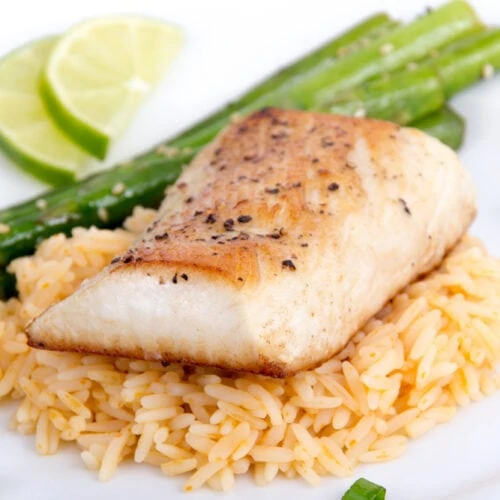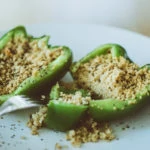Make easy pan-seared mahi mahi with a quick garlic butter dice for a light but satisfying seafood dinner.
Mahi mahi is a lean, flaky white fish that tastes amazing with a little bit of sauce.
How do you cook mahi mahi? First dry the filets well, then season them with lemon, salt, and pepper. Next, pan-fry them with olive oil until cooked through and flaky. Before serving, make a quick finishing sauce using garlic, butter, and lemon, drizzle it on top, and enjoy!
How to cook the best mahi mahi
Cooking mahi mahi can prove tricky for some people – but don’t panic!
Even if this is your first time ever preparing this flaky white fish, these three tips will help you perfect the dish:
- Choose the freshest catch. The best way to ensure that your fillets are of the highest quality and very fresh is to talk with the person behind the fish counter. The first question to ask, regardless of the kind of seafood you’re shopping for, is when the fish came in. Ideally, the mahi mahi landed in the store from the fishing bot that day. If not, ask about flash-frozen mahi mahi. Often, the fish has been frozen right on board the fishing boat fresh out of the water for the best flavor. This is a good option if you don’t have access to freshly caught seafood nearby. Other things to look for are that the fish flesh is firm, white and moist looking. It should not be dry or have any gapping between the flakes.
- Dry right to season right: white fish like mahi mahi aren’t always the most flavorful on their own. That’s why seasoning is so vital in this recipe for pan-seared mahi mahi. However, before you can season properly, the first step is to dry the fish well. Take care to gently pst the fish dry with a paper towel before you add any seasonings. This removes moisture so that the fish flesh can readily absorb the seasonings.
- Temperature is key: When it’s time to put the mahi mahi in the skillet to start cooking, the temperature needs to be blazing hot. The oil should be just on the verge of smoking when you put the fish in the pan. Make sure you warm up the pan before you pour the olive oil! This way, your fillets will get perfectly crisp on the outside and cook quickly.
How to make pan-seared mahi mahi
Now that you have the three most important tips for cooking mahi mahi down pat, you’re ready to start cooking. Let’s get to the recipe.
Ingredients
Here is what you need to make tasty pan-seared mahi mahi to feed four:
- 4 mahi mahi filets
- 1 lemon
- 1 minced clove of garlic
- 4 tablespoons of unsalted butter
- Olive oil
- Salt
- Pepper
If you’re feeding more or fewer people, you can easily scale this recipe up or down to fit your needs without making any changes to the cooking times or recipe steps.
Prepping mahi mahi
Step 1: Dry the mahi mahi
Use paper towels to gently dry the mahi mahi fillets. The drier the filets are, the better seasoned they will be, so be thorough. Use a light hand to avoid damaging the flesh at all.
Step 2: Season the mahi mahi
Cut the lemon in half and save one half for later. With the remaining half, squeeze lemon juice over each fillet of fish.
Next, sprinkle the fillets with salt and pepper on both sides. While you can add other dried seasonings at this point if you like, a simple preparation of salt, pepper and lemon makes an elegant dish that lets the delicate flavor of mahi mahi speak for itself on the plate.
Cooking mahi mahi
Step 1: Heat up a pan
Now that your fish is properly seasoned, it’s time to start cooking. Use a large skillet to pan-sear the mahi mahi. Heat the pan over medium-high heat. Wait for a bit until the pan is hot before drizzling in the olive oil. Swirl the oil around the pan so you have an even, thin coating of oil for searing. When the oil is hot but not yet smoking, move onto the next step.
Step 2: Cook the mahi mahi
Carefully Place the mahi mahi fillets into the hot pan. cook until each piece is brown on the bottom, then use a thin fish spatula to carefully flip the fillets and brown the other side. The first side should take 3-5 minutes, depending on the thickness of your fish. The second side will need a bit less time, about 2 to 3 minutes.
Keep a close eye on the fish in the skillet as it can overlook quickly. The fish is done when it’s no longer translucent in the center and flakes easily with a fork.
Step 3: Serve the mahi mahi and keep cooking
Just before your fish is fully cooked, remove it from the hot skillet and plate it up. The fillets will continue cooking for a few minutes after you remove them from the skillet.
Now, you can make a quick and delicious pan sauce in the same skillet while the fish rests.
To do this, reduce the heat to medium-low. Then squeeze the juice from the remaining lemon half into the pan. Add the minced garlic and ¼ teaspoon of salt as well.
Finally, add the butter. Stir the sauce and cook until the butter is fully melted and well combined with the lemon juice. Taste your sauce and add salt and pepper to taste.
Step 4: Plate everything together
Finally, plate the mahi mahi and spoon the sauce on top. Enjoy!
How do you know when mahi mahi is done?
There are two ways to check whether mahi mahi is done or not. The most accurate way is to check its temperature. According to FoodSaftey.Gov, mahi mahi should be eaten at 140°F (60°C).
However, if you don’t have an instant-read thermometer to check the temperature, you can cut a little bit of mahi mahi and check its inner color. It should look opaque and its juices should be clear.
What does mahi mahi taste like?
Mahi has a delicate and mild flavor. It’s not without seafood taste, though. Mahi mahi is a great choice for someone who enjoys seafood but may not want the overly fishy experience of shellfish or salmon, for example. And when the fillet is garnished with a buttery gari cand lemon sauce, even a seafood hater might just enjoy the dish.
What to serve with pan-seared mahi mahi
You can pair this simple and refined garlic-lemon mahi mahi dish with a wide range of sides. For something starchy, try fluffy jasmine rice or cooked barley. If you want to pair it with a vegetable, anything from spaghetti squash to broccoli would be delightful. Or, to wow guests with an all-out surf and turf experience, why not add a seared fillet mignon on the side?

Pan-seared Mahi Mahi
Equipment
- Large skillet
- Fish spatula
- Chef's knife
- Cutting board
Ingredients
- 4 mahi mahi filets
- 1 lemon
- 1 clove of garlic minced
- 4 tablespoons of unsalted butter
- Olive oil
- Salt to taste
- Pepper to taste
Instructions
- Use paper towels to gently dry the mahi mahi fillets. The drier the filets are, the better seasoned they will be, so be thorough. Use a light hand to avoid damaging the flesh at all.
- Cut the lemon in half and save one half for later. With the remaining half, squeeze lemon juice over each fillet of fish.
- Next, sprinkle the fillets with salt and pepper on both sides. While you can add other dried seasonings at this point if you like, a simple preparation of salt, pepper and lemon makes an elegant dish that lets the delicate flavor of mahi mahi speak for itself on the plate.
- Now that your fish is properly seasoned, it’s time to start cooking. Use a large skillet to pan-sear the mahi mahi. Heat the pan over medium-high heat. Wait for a bit until the pan is hot before drizzling in the olive oil. Swirl the oil around the pan so you have an even, thin coating of oil for searing. When the oil is hot but not yet smoking, move onto the next step.
- Carefully Place the mahi mahi fillets into the hot pan. cook until each piece is brown on the bottom, then use a thin fish spatula to carefully flip the fillets and brown the other side. The first side should take 3-5 minutes, depending on the thickness of your fish. The second side will need a bit less time, about 2 to 3 minutes.
- Just before your fish is fully cooked, remove it from the hot skillet and plate it up. The fillets will continue cooking for a few minutes after you remove them from the skillet.
- Reduce the heat to medium-low. Then squeeze the juice from the remaining lemon half into the pan. Add the minced garlic and ¼ teaspoon of salt as well.
- Finally, add the butter. Stir the sauce and cook until the butter is fully melted and well combined with the lemon juice. Taste your sauce and add salt and pepper to taste.
- Plate the fillets and spoon the lemon garlic sauce on top.












